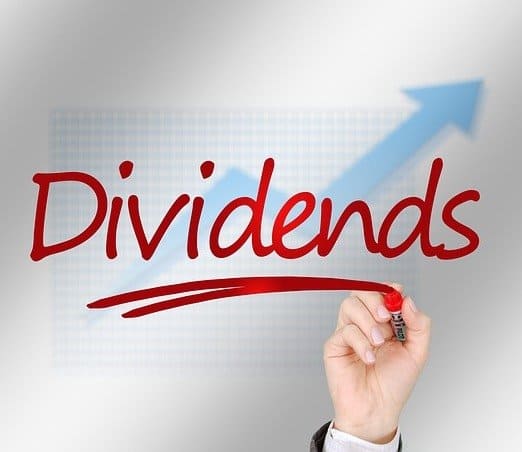Calculate Expected Dividend Per Share To Get Your Future Dividends
Today I want to explain how to forecast dividends. Because future dividend growth is a key benefit of dividend investing.
Since regular dividend increases mean you are making more money from dividends every year. But how much more passive income can you expect from your dividend stocks?
Let’s find out by discussing how to forecast dividends. And why you should.

Disclosure: At no cost to you, I may get commissions for purchases made through links in this post.
How To Forecast Dividends
How do you forecast dividends? Allow me to explain…
To forecast dividends per share. Simply take a company’s current annual dividend payment. And multiply it by an estimated dividend growth rate.
The challenge here is estimating the dividend growth rate. I have much more on that topic in a moment.
But first, let’s make sure to understand the calculation…
Hypothetical Example Of Calculating Future Dividends Per Share
For example, let’s say a company pays a current annual dividend of $1 per share. And you estimate the dividend per share will grow by 5% each year.
So the dividend per share next year will be $1.05. Or, $1 multiplied by 1+5%.
In 2 years the dividend will be $1.1025. Calculated as $1 times 1.05 times 1.05.
Repeat the process for as many years into the future you like. Or, use a financial calculator.
With a financial calculator, input the annual dividend today. The estimated annual dividend growth rate. Finally, the number of years in the future you wish to forecast.
Then the calculator solves for the future annual dividend payment. That’s how I go about calculating expected future dividends.
Why Forecast Dividends?

I know of 3 good reasons for estimating a stock’s dividend growth rate. And using the rate for forecasting future dividends.
- Provides an expectation to measure future dividend increases against
- Allows an investor to estimate their future cash flow from dividends
- Is useful for valuing dividend stocks
I’d like to explore these reasons for dividend investment growth estimates later. But now, I want to circle back to the calculation for forecasting dividends.
Since we know future dividends are based on the annual dividend per share today. And, an estimated dividend growth rate.
I want to break down these two components of the calculation…
Current Annual Dividend Per Share
This part of the calculation for how to forecast dividends is easy. I’m talking about the annual dividend per share.
It can be found on a company’s website. Or, sourced from one of the many financial sites on the internet.
Just look up the last dividend payment approved by the company. And multiply it by the number of times the company pays dividends each year.
The resulting number is the current annual dividend per share. Also known as the forward annual dividend rate.
So, we have the first of the two inputs for the calculation. But, what about the 2nd input. That being the estimated dividend growth rate.
Well, that’s a little more difficult. On the other hand, it is the most valuable part. Let’s discuss…
Estimated Dividend Growth Rate

When making estimates about the future. Or, projecting what will happen. There is no one right answer.
It’s like forecasting the weather. Using forecasting methods, the weatherman or woman makes their best guess. About what is going to happen with the weather.
Same for the estimated dividend growth rate. There is no 1 exact answer. Just a best guess based on dividend forecasting methods.
So, how do dividend investors make their best guess? About a company’s estimated dividend growth rate? Allow me to explain…
Estimating the dividend growth rate is done by looking at specific data. Then applying judgment to that information. To make a dividend forecast.
I estimate the dividend growth rate for every stock I own. For me, it’s part of doing dividend growth investing at a high level.
And here is the information I like to look at…
The Company’s Stated Dividend Policy
Most companies do not state their dividend policy publicly. But when they do, it makes estimating dividend growth rate fairly easy.
Wisconsin Energy Group, stock symbol WEC, is an excellent stock for example purposes. In the recent past, management has communicated to investors the following information:
- Targeting a dividend payout of 65-70 percent of earnings
- Projecting dividend growth in line with earnings growth
- Expecting earnings to grow 5-7% annually
From this information, estimating the dividend growth rate is easy. I project the dividend will be increased by about 6% each year.
Because earnings are expected to grow 5-7%. And the dividend is projected to grow a similar amount.
But, if a company has a stated dividend policy. You still have to find it.
Typical sources include press releases announcing dividend increases. Or, investor materials supplied on the company’s website.
What if you can’t find a clear dividend growth policy statement? Then look at this next…
Historical Dividend Growth Rate

On one hand, history can be a great guide for the future. On the other hand, past performance is no guarantee of future results.
So, use a company’s dividend growth rate history as a guide. Not a guarantee about future dividends.
Let’s use another example. This time the diversified health care firm, Johnson & Johnson. Or, J&J for short (NYSE: JNJ).
At the time of publication, J&J had a compound annual dividend growth rate of a little over 6%. During the last 3, 5, and 7 year periods.
Furthermore, their last dividend increase came in at a little over 5%. So, I can calculate expected dividends will be 5-6% higher each year. Using history as a guide.
In my opinion, dividend policies and past dividend growth rates are the best information. To use when forecasting future dividends from stocks.
But some other things can be helpful to fine-tune your estimate.
The Company’s Profit Forecast
While a company may not tell us how fast they intend to grow their dividend. They often communicate how much they plan to grow profits.
So, you should understand how a company’s earnings and dividends forecast. Are closely related.
If we assume a company’s dividend payout ratio will remain relatively constant. Then we may infer the dividend will grow at about the same rate as their profit growth forecast.
Combine the dividend growth rate from the past. With an expectation for future profit growth. And boom, you have some good inputs to forecast your recurring future dividend payments.
You may have noticed that I mentioned the dividend payout ratio a couple of times. Here is a little more on that dividend metric.
To use it in learning how to calculate expected dividends per share. As part of your quest to understand how to forecast dividend payments…
Dividend Payout Ratio
The dividend payout ratio is an indication of the dividend payment capacity of a firm. And provides clues about future dividends.
The payout ratio simply tells us dividends being paid. Versus accounting earnings. Or, a company’s available cash flows.
Thus, the dividend payout ratio is stated as a percentage. The lower the percentage. The greater the available dividend payment capacity a company has.
This allows a company with a low dividend payout ratio. The opportunity to increase dividends more rapidly in the future. Even if profit growth is a lesser amount.
On the other hand, a very high dividend payout ratio probably means dividend growth will be lower than profit growth. Until the dividend payout ratio drops to a more comfortable level.
To sum up. The dividend payout ratio. Can tell us a lot about companies that pay dividends.
Economic Conditions
Finally, don’t forget to factor in overall economic conditions. This is more important for short-term estimates of dividend growth rate. Say 1-2 years out.
For example, if the economy is in a deep recession. Expect slower dividend growth. Because companies will be more conservative with their cash.
On the other hand, if the economy is booming. Faster dividend growth may result.
Okay. So there you have some good things to look at. When calculating the expected dividend per share.
To summarize, gather and review this information:
- Dividend policy (when available)
- Historical dividend growth rate
- Management’s profit forecasts
- Recent dividend payout ratios
- Current economic conditions
By doing so, you will gain valuable information about how a dividend-paying company operates.
And focus your research efforts on dividend growth. Rather than dividend yield.
Next, let’s tie all of these elements together into an example. I will use one of the stocks I cover here at Dividends Diversify.
How To Forecast Dividend Growth: Using Clorox As An Example

I would like to use Clorox for example purposes. The stock trades using symbol CLX.
Using Dividend Policy To Forecast Dividends
First of all, I have reviewed the company’s investor materials. And press releases announcing their recent quarterly dividend payments.
Unfortunately, I see no sign of a dividend policy that is communicated publicly. But I know for a fact. That Clorox has increased its dividend every year starting back in 1978.
Making me fairly certain about 1 thing. That they will continue to increase their dividend every year going forward.
I just do not know by how much. At least not yet…
Historical Dividend Growth Rate
I calculated the Clorox historical dividend growth rate. And I did it for the last 3, 5, and 7 year periods.
In each case, it fell between 7% and 10%. That’s some nice annual dividend growth. And, a fairly consistent range to work with.
Profit Forecasts For Forecasting Dividends
I noted in the Clorox investor materials. Located on their website.
That they intend to grow sales annually by 2-4%. And increase their profit margins by one quarter to one-half percent each year.
So, they haven’t provided a specific profit growth forecast. But they have provided enough information to forecast they can grow profit by 5%-7% annually.
I also noted that 5-7% is in line with their historical profit growth. Over the past several years.
Using The Dividend Payout Ratio To Forecast Dividends
Next, I looked at the Clorox dividend payout ratio. And noted that dividends per share. Run consistently at or around 60% of earnings per share.
And, I have no reason to believe that Clorox will deviate from that level. Meaning the Clorox dividend will grow at about the same rate as their profits.
Economic Conditions Can Influence A Dividend Forecast
Last, I know business has been good for many of the company’s products. Especially, cleaning supplies.
So, if anything, current economic conditions may provide additional support. For rising profits. And increasing dividends.
Forecasting The Company’s Dividend Payments
Now it is time to apply some professional judgment. Looking at the information I just discussed.
Furthermore, your judgment will improve with time. As you analyze your best dividend stock holdings.
So what is my forecast of future dividends from Clorox? Well, I estimate the Clorox dividend growth rate will be 7% going forward. At the high end of the earnings growth rate.
This takes into account favorable economic conditions for cleaning supplies. That may persist.
And allows for the dividend payout ratio to remain constant. At about 60% of earnings.
On the other hand, the forecast is at the low end of their historical dividend growth rate. During the past 3, 5, and 7 years. Since I do not think the company can keep up with that pace of dividend growth moving forward.
So, that is how to forecast dividends.
Will my forecast be correct? I don’t know.
Just like predicting the weather. I may be wrong.
But that’s okay. Look how much I have learned about Clorox and its dividend. On a side note. Clorox is a great stock for a beginner’s dividend portfolio.
Doing an exercise like this is great investment research. For the dividend stocks, that you buy and hold.
Forecasting Future Dividends Made Easy
If this seems like too much work. I have a suggestion.
I use the Simply Investing report to gather the data much faster. Because Simply Investing provides much of the information I have discussed. That can be used for your dividend stock analysis to forecast dividend payments.
For example, historical information such as profit growth, dividend payout ratio, and dividend growth rate are all included in the Simply Investing Report. For the hundreds of dividend stocks they cover.
Then, all you have to do? Make a judgment about the future.
Finally, you can learn more about Simply Investing here.
But, before I wrap up. What benefits does forecasting dividends provide?
Let’s discuss….
Reasons To Forecast Dividends

Here are the reasons I find forecasting dividends useful. For the dividend stocks that I own. Maybe you will too?
Forecast Dividends To Set Expectations
Each year management of companies that pay rising dividends. Announce their dividend increase.
So, a dividend forecast sets an expectation. Otherwise, how else will we know if their dividend increase announcement is good or bad?
First of all, if management announces an increase higher than my forecast. I’m happy. And I feel comfortable that the company is performing well.
On the other hand, if the announced dividend increase falls below my expectations. It prompts me to take a closer look.
And see what may be going wrong. At the company. Or, with my forecast assumptions.
Maybe, I need to consider selling the stock. And buying a better dividend stock to replace it.
Regardless, when I decide to make a trade. I do it for free. Using my Webull app.
The Webull app is fast and powerful. It adds even more efficient research capabilities. To a dividend investor’s toolkit.
You can learn more about Webull here.
Forecast Dividends To Project Future Dividend Income
Earning dividends is important to me. To cover living expenses. If you have read this far, I suspect dividend income is important to you too.
For example, if I make $100 a year from Clorox dividends. And I believe the dividend will grow by 7% each year.
I know next year I can expect to make $107. Then, $115 the year after that. And so on.
Furthermore, hold your dividend stocks in an individual retirement account (IRA) and you won’t have to worry about paying taxes.
But back to dividend growth…
The great thing about it? You or I do not have to do anything to make more dividends.
Because when it comes to organic dividend growth. The company is doing all of the work.
Just like you hope and expect to get a raise in pay from your employer each year. And perhaps plan on it to increase your standard of living. The same goes for forecasting dividend payments.
And will all that money rolling in from dividend stocks. Be sure to manage it efficiently.
For this purpose, I like Personal Capital. Because it consolidates all of my investments and spending in one place online.
Best of all, Personal Capital is free to sign up and use. You can learn more about Personal Capital here.
Forecast Dividends To Use A Dividend Discount Model
Finally, a good way to value dividend stocks is by using dividend discount models. One such popular dividend valuation formula is called the Gordon Growth Model.
By knowing the current annual dividend payment. An estimated dividend growth rate. And how much annual return on investment you desire. You can calculate the fair value for a dividend stock.
Then, by comparing the stock’s fair value to the current market price. You, the dividend investor, can make a more informed decision on whether to buy, sell, or hold.
Okay. It’s time to wrap up. With a summary…
Summary: How To Forecast Dividends And Why You Should
So, how do you forecast future dividends? It’s easy…
Take a company’s current annual dividend payment. And multiply it by an estimated dividend growth rate. To calculate the expected dividend per share.
The calculation is simple. And obtaining a company’s forward annual dividend rate is easy to look up.
The challenge comes in when estimating the dividend growth rate. To do so, collect the following information:
- Dividend policy (when available)
- Historical dividend growth rate
- Management’s profit forecasts
- Recent dividend payout ratios
- Current economic conditions
Review the facts. And apply your judgment to estimate the dividend growth rate. Then you know how to calculate the expected dividend per share.
Finally, here are 3 good reasons to forecast dividends. For the dividend stocks, you own. Or, the stocks on your watch list.
- Provides an expectation to measure future dividend increases against
- Allows an investor to estimate their future cash flow from dividends
- Is useful for valuing dividend stocks
Happy forecasting. Remember it’s like predicting the weather. There is no one exact answer.
And it’s okay to be wrong. Because there is value in working the process. The process of forecasting future dividends.
More Reading About Making Money With Dividends
- 5 favorite Vanguard dividend ETFs
- How to make dividends every month
- 10 stocks paying dividend every quarter
My Favorite Dividend Investing And Finance Tools
Throughout the article, I mentioned the most helpful tools for your dividend investing journey. So, gear up and do your financial planning in style.
I have summarized them here for your convenience.
- Trade stocks for free with the Webull app
- Get dividend stock recommendations from Simply Investing
- Get top stock picks from Motley Fool
- Manage all of your finances with Personal Capital

Author Bio: Tom Scott founded the consulting and coaching firm Dividends Diversify, LLC. He leverages his expertise and decades of experience in goal setting, relocation assistance, and investing for long-term wealth to help clients reach their full potential.